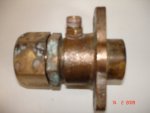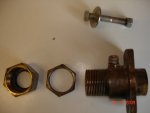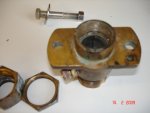You are using an out of date browser. It may not display this or other websites correctly.
You should upgrade or use an alternative browser.
You should upgrade or use an alternative browser.
Weeping around the stern gland... What action?
- Thread starter Captain Crisp
- Start date
Captain Crisp
Well-Known Member
That is a pretty standard set up. The tube is held in place by the stuffing box housing screwed onto the tube and attached to the little bulkhead with the 2 locking screws (or they might be bolts with nuts on the aft face - difficult to tell from the photo). Exactly the same as the aft end where the tube is located by the bearing housing screwed on and locked to the hull.
I am still puzzled by why you want to remove the tube, but if you do then the procedure is to undo the inner and outer bearing housings and pull the tube out. This will of course break the watertight seal where the tube goes through the deadwood in the hull. Often the aft end is glassed in so it does not leak and is permanently fixed in place. However the fact that you can turn the tube suggests it is sealed with a flexible sealant at the aft end which has probably failed.
This will give you a good idea of how it works
sillette.co.uk/catalogue.pdf#page=4
Thanks, Tranona, that's really helpful. I'm actually very keen not to have to remove the stern tube!
But people seem to be suggesting that water from inside the tube may escape through the unsealed threads at either end, especially now that I have been turning it.
So I was planning to unscrew it at the front end, apply thread sealant and screw back up and then do the same at the aft end, once I've fitted my new cutlass...
That's the theory, anyway... Do you think I would need to remove the shaft, or could I leave that in place and work around it?
Thanks!
Crisp
Tranona
Well-Known Member
Really don't think you have a problem. When the tube was made to length the threads would be close to bottom when the housings are screwed up and the locking bolts put in. I had a similar arrangement for many years and had the housings off both end several times because of changes of engines, shafts, seals etc. Never put any sealer specifically on the threads, just on the face of the housing. The weakness in your arrangement from what I see from your photos is the gap around the tube where it goes into the hull (and the fact that the tube can turn) which suggests it is a loose fit in the GRP "deadwood" rather than being glassed in solidly as is more common. As I suggested earlier I think I would put a ring of caulking cotton set in non setting sealer around the tube where it meets the GRP and then more sealer on the face before you put the housing back on. That is the only route for water into the boat and will now be sealed up. Would not worry about the inboard end. Just screw the tube back up as far as it will go before you put the back end together.
penfold
Well-Known Member
There's seawater in the tube, ergo the threads must have a sealant. I'd be surprised if the tube won't shift with a pair of plumbers grips or a stilson if there's the length sticking out to grip without marring the thread.
Tranona
Well-Known Member
The problem is that you don't know what is in the aft end where the tube goes through the deadwood and I would be loath to remove it as that could introduce more problems of sealing it when replacing it. As i said normally the tube is glassed in to prevent any movement or leakage so at the moment sealing the gap around the aft end of the tube and the cutless housing will stop water getting into the boat. At the forward end, the stuffing box housing is bedded in sealer and seals that end of the tube as you can see from the photo in post#61.
penfold
Well-Known Member
I don't see any glassing here, although only the OP can definitively state what the boat has. At the risk of making assumptions; there are 4 paths for water ingress, hull/cutlass bearing housing interface(green arrow), the threaded joints(red arrows) and the stern gland itself(blue arrow). Having disturbed whatever mastic/sealant there is on the forward threaded joint it seems short-sighted to not remove, clean and apply fresh sealant to the joint while the rest of the assembly is apart.
Edit to add; there are also the fasteners for the cutlass housing as a potential ingress path, if they are not into a captive thread getting nuts on will be 'super double fun time', especially the lower one.

Edit to add; there are also the fasteners for the cutlass housing as a potential ingress path, if they are not into a captive thread getting nuts on will be 'super double fun time', especially the lower one.

To revisit this; the Sillette catalogue linked to above lists prop nuts like this alongside anodes which are secured using the tapped hole in the end; also listed are tab washers clearly intended to secure the nut once tightened.Thanks!
- The tapered prop nut came off rather easily and doesn't have a pin or anything to keep it in place. It seems to have a small threaded opening on the point of its tapered end. Should something be in there?
Crisp
View attachment 113073
Last edited:
Poignard
Well-Known Member
A perfect illustrationI don't see any glassing here, although only the OP can definitively state what the boat has. At the risk of making assumptions; there are 4 paths for water ingress, hull/cutlass bearing housing interface(green arrow), the threaded joints(red arrows) and the stern gland itself(blue arrow). Having disturbed whatever mastic/sealant there is on the forward threaded joint it seems short-sighted to not remove, clean and apply fresh sealant to the joint while the rest of the assembly is apart.
View attachment 113828
[..]
Other threads that may be of interest
- Replies
- 4
- Views
- 256



